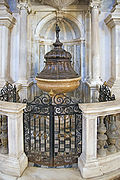San Moisè, Venice

The Chiesa di San Moisè (or San Moisè Profeta) is a church in Venice, northern Italy, built initially in the 8th century. It is dedicated to Moses as, like the Byzantines, the Venetians tended to canonise Old Testament prophets. It also honors Moisè Venier, who paid for it to be rebuilt in the 9th century.
The elaborate Baroque facade, dating from 1668, is covered in carvings. Some of its sculptures are generally attributed to Heinrich Meyring. It is attributed to Alessandro Tremignon, with patronage by Vincenzo Fini, whose bust is found over the entry door. Statues in public spaces were forbidden in Venice. By putting his bust on the facade of a church, he could circumvent this ordinance and, like a rich parvenu, show off with his wealth and his only just acquired title of nobility.
The interior is dominated by Meyring's huge and mannered sculptural set piece and altarpiece, depiction Mount Sinai with Moses receiving the Tablets, created by Tremignon and Meyring. Behind it is a canvas by Michelangelo Morlaiter. It also has a Washing of Christ's Feet by Tintoretto, and a Last Supper by Palma il Giovane. A Deposition was painted in 1636 by Niccolò Roccatagliata in collaboration with Sebastiano.
John Law, originator of the Mississippi Scheme, is buried in the church.
San Moisè is the parish church of one of the parishes in the Vicariate of San Marco-Castello. The other churches within the parish are Santa Maria Zobenigo, San Fantin, Santa Croce degli Armeni and the Basilica of San Marco itself.
Gallery
-
Cenotaph for Girolamo Fini († 1685)
-
Baptismal font
-
Organ
-
Ceiling
Sources
- Extracted from Italian Wikipedia.





